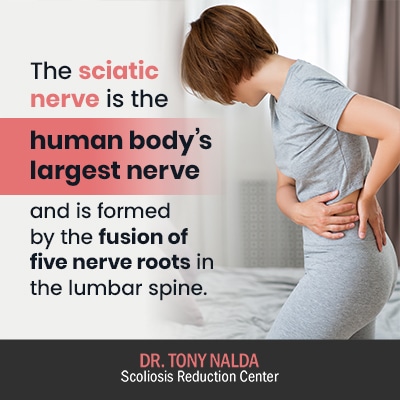Nerves are like branches of a tree, fanning off in multiple directions, which is why nerve pain isn’t solely confined to its site of origin but can be felt throughout the body. Suppose a nerve, such as the sciatic nerve, is exposed to uneven pressure or compression. In that case, nerve endings become irritated and cause varying pain levels felt anywhere along the nerve’s pathway.
Sciatica refers to pain felt along the sciatic nerve path, starting in the lower back and extending through the hips, buttocks, and down the back of the leg. The most common causes for sciatica include a herniated disc, bone spurs, or a condition like spinal stenosis that narrows nerve space.
What is Sciatica?
As mentioned, the sciatic nerve starts in the lumbar spine (lower back) and extends through the hips, buttocks, down the backsides of both legs, into the heels and soles of the feet.

The sciatic nerve is the human body’s largest nerve and is formed by the fusion of five nerve roots in the lumbar spine.
The sciatic nerve plays a crucial role in connecting the spinal cord, the skin, thighs, legs, and feet.
Sciatica is a condition that references pain and neurological symptoms that originate from the sciatic nerve; pain is felt along the sciatic nerve’s pathway, and sciatica has many causative sources.
What Causes Sciatica?
When the sciatic nerve becomes irritated, compressed, or inflamed, this can be caused by several lower-back issues.
As a type of lumbar radiculopathy, sciatic nerve pain originates from the lumbar/and or sacral nerve roots.
The sections of the spine include the cervical spine (neck), thoracic spine (middle/upper back), lumbar spine (lower back), and the sacrum (bony structure at the base of the lumbar spine that connects to the pelvis).
Mechanical compression of the sciatic nerve involves direct physical force being applied to the nerve and is most commonly caused by herniated discs, spinal stenosis, bone spurs, and segmental instability.
Herniated Discs
The bones of the spine (vertebrae) are stacked in a neutral alignment and are separated by intervertebral discs.
The spine discs sit between adjacent vertebrae and perform many important roles essential in preserving the spine’s optimal health and function.
The discs have a tough and durable outer layer and a soft gel-like interior. The intervertebral discs cushion the vertebrae, so friction isn’t generated during movement. They enable flexible movement, provide structure by connecting the vertebrae, and act as the spine’s shock absorbers, so mechanical stress is evenly absorbed/distributed.
As they are often the first structures of the spine to show the effects of degenerative changes, many spinal conditions/issues are related to the health/function of the intervertebral discs.
When a disc in the lumbar spine develops a bulge or becomes herniated, this can cause irritation and compression of one or more of the sciatic nerve roots.
When a disc bulges, its inner nucleus does not retain its central position inside the disc and pushes on the exterior annulus’s outer edge.
When a disc’s inner nucleus pushes through a tear in the outer annulus, this is known as disc herniation.
When a disc herniates, its inner nucleus protrudes into spaces within the spine through which important spinal nerves pass. When a disc herniates in the lumbar spine, it can affect sciatic nerve roots and cause sciatica.
Chemical Inflammation
Chemical inflammation is another potential cause of sciatica, as research suggests a link between chemical irritants and sciatic nerve inflammation/irritation.
Chemical irritants include hyaluronic acid and fibronectin (protein fragments) that leak out of degenerating or herniated discs.
Sometimes, degenerated discs can also cause nerve tissues to grow into a disc, which penetrates both the inner and outer layers of a disc and can cause sciatic nerve pain.
It’s also been suggested that immune system response can play a role in sciatica when disc material is exposed; certain substances (fats and protein polymers) secreted by the immune system are known to be in excess for people with sciatica.
This increased level of substances secreted by the immune system in people with sciatica is thought to be due to a reaction between nerve roots and exposed disc material. This reaction can be the cause of sciatic nerve inflammation.
Spinal Stenosis
As the brain and spine work in tandem to form the body’s central nervous system, spinal conditions often impact the nerves that pass through the spine, which is why symptoms are not confined to the back but can be felt anywhere along the route of a nerve’s pathway.
Spinal stenosis is the narrowing of an intervertebral opening through which the sciatic nerve roots pass. When there is a loss of space within the spine caused by the narrowing of an intervertebral gap, compression and irritation of the sciatic nerve and sciatica may develop.
Spinal degeneration, particularly related to the intervertebral discs, such as in degenerative disc disease (DDD), or a thickening of the facet joint capsules and ligaments can also cause direct compression of the sciatic nerve.
Bone Spurs
Bone spurs are abnormal bone growths that develop along the edges of bones, often referred to as bony projections.
Also called osteophytes, bone spurs commonly develop where bones meet in the joints and form on the bones of the spine (vertebrae).
The main cause of bone spurs is joint damage caused by osteoarthritis.
Many patients with bone spurs don’t experience noticeable symptoms. But, if particularly severe or when located in the lumbar spine, these abnormal bone growths can encroach upon the space within and around the spine and irritate surrounding nerve endings, such as the sciatic nerve.
Segmental Instability
The spine consists of many moveable structures, and spinal biomechanics are determined by how these parts interact.
As mentioned, the spine is made up of vertebrae stacked on top of one another and separated by intervertebral discs.
Each spinal segment consists of a vertebral body, an intervertebral disc, and a pair of facet joints, forming a 3-joint complex.
When one structure within a segment starts to deteriorate, its effects aren’t isolated solely to the structure itself but also impact the other structures.
When a vertebral segment becomes unstable, it tends to shift the segment’s position, which can disrupt the alignment of the entire spine, as each healthy and natural spinal curve depends upon the others.
There are different causes of segmental instability. These causes include progressive structural spinal conditions such as scoliosis, spondylolisthesis (when one vertebra slips down over the one below), spondylolysis (vertebral defects), or an injury that involves the complete dislocation of one or more vertebrae.
In addition, although not as common, the presence of tumors, cysts, or abscesses, in the lumbar spine or pelvis can also cause compression of the sciatic nerve and the development of sciatica.
So now that we have defined sciatica and discussed some of its most common causes, what is it like to live with sciatic nerve pain, and what are some other symptoms of sciatica?
Sciatica Pain
Nerve-related back pain can be one of the most debilitating forms of back pain as its effects aren’t always isolated to the back but can be felt throughout the body.
Sciatic nerve pain can range from mild and intermittent, with noticeable flare-ups, to chronic and debilitating.
Many factors can shape a person’s life experience with sciatica, from patient age and overall health to causation and the degree of nerve involvement.
While every case is different, in general, the more compression or irregular forces the sciatic nerve is exposed to, the more pain it’s likely to cause.
As a type of radiculopathy (pain caused by compression of spinal nerve roots), sciatica develops when one or more nerve roots from L4 (4th vertebra of the lumbar spine) to S3 (3rd vertebra of the sacral spine) are compressed or irritated. Commonly due to disc issues, stenosis, or general spinal deterioration.
Further reading: Cervical Radiculopathy Treatment: What You Need To Know
When the sciatic nerve is compressed, radicular pain from the root is most commonly felt in the thigh, calf, and foot: far from the original site of nerve compression.
You might also notice that thigh, calf, and foot are singular, and this is because sciatic nerve pain is most typically felt down one side of the body, most commonly the left.
Additional symptoms can also accompany sciatica, most typically affecting one or more areas of the lower back, thigh, leg, and foot.
When sciatic nerve pain lasts less than eight weeks, it’s called acute sciatica, and pain duration that extends past eight weeks is considered chronic sciatica.
Now that we have discussed sciatica pain in general terms let’s focus on the nature of varying types of sciatic nerve pain.
Different Types of Sciatica Pain
In most cases, pain is the first symptom of sciatica and commonly indicates nerve irritation and/or inflammation.
Patients commonly describe sciatic nerve pain as a sharp, searing, or burning pain in the lower back and in one leg.
Other pain descriptions include:
- Electric shock-like pain
- Shooting pain
- Throbbing/pulsating pain
- A constant dull ache
- Pain that comes and goes
In rare cases, sciatica can affect both legs simultaneously, and in some cases, pain can alternate between the left and right leg.
As sciatica pain develops along the sciatic nerve’s path, including its branches, most commonly, the back and outer part of the thigh and/or leg is affected, but other regions of the body that are vulnerable to its effects can include:
- Lower back
- Front or back of the thigh/thighs
- Front or back of the leg/legs
- Top and outer side of a foot/feet
- Webbed area between the first and second toe
- Foot/feet sole
Typically, sciatica is more associated with leg pain than back pain.
Neurological Symptoms of Sciatica
While pain is the most common symptom of sciatica, neurological symptoms can accompany sciatic nerve pain.
Sciatic nerve compression is also known to cause:
- Thigh-muscle weakness
- Leg/foot-muscle weakness
- Feelings of numbness in the calf, heel, sole, or top of a foot
- Paresthesia (odd sensations felt on the skin due to improper nerve conduction)
When neurological symptoms are involved, functional deficits can develop in the affected leg and are most commonly related to sciatic nerve compression.
While rare, there are instances when sciatica symptoms indicate a serious sciatic nerve injury and can indicate the presence of an underlying medical condition such as cauda equina syndrome, infection, or spinal tumors pressing on the spine.
So if a person has sciatica, what can be done in terms of pain relief?
Sciatica Pain Relief
When it comes to sciatica pain relief, while each patient is different, there are some general noninvasive strategies that are known to bring some sciatic nerve pain relief.
One of the biggest mistakes people make when experiencing back pain is to stop moving; this is an understandable response, particularly if movement exacerbates the pain.
The spine’s very design is based on movement, so remaining sedentary can be bad for spinal health and function even for short periods of time.
In addition, as people become less active, they lose muscle mass. The muscles of the abdomen and those surrounding the spine are instrumental in providing the spine with crucial support and stabilization.
Not moving is a common response to back pain, but it is one of the worst things a person can do with a variety of spinal conditions/issues.
While some spinal injuries, particularly overuse injuries, require time and rest, in the majority of cases with back pain, continuing low-impact gentle exercise can bring pain relief by keeping the spine and its surrounding muscles as strong, loose, and flexible as possible.
Alternating hot/cold therapy is also a noninvasive means of providing pain relief for sciatica by numbing painful areas and relaxing sore muscles and joints.
There are also some helpful sciatica stretches that can provide pain relief.
Sciatica Stretches
Sciatica pain can also be the result of piriformis syndrome. The piriformis muscle starts in the buttocks at the edge of the spine and extends to the top of the thigh.
If the piriformis muscle spasms, it can trap the sciatic nerve, located in the same area, and this is another cause of sciatic nerve pain.
When it comes to sciatica stretches, condition-specific exercises and stretches prescribed by a physical therapist have the potential to keep important muscles, such as the piriformis, as loose and strong as possible.
Part of the treatment process for sciatica is identifying parts that aren’t moving as they should, most commonly the lower back and hips, which makes sense as it’s the lower back and pelvis that support the majority of the body’s weight.
Stretches that can externally rotate the hip can be a highly effective, safe, and noninvasive form of pain relief as they loosen the hip and pelvis.
Some of the most commonly-used stretches for sciatic nerve pain relief include:
- Sitting pigeon pose
- Reclining pigeon pose
- Standing piriformis stretch
- Knee-to-opposite-shoulder stretch
- Sitting spinal stretch
While there are always pain medications, prescriptions and/or over-the-counter, these only provide short-term pain relief. In contrast, effective treatment that addresses the underlying cause of the sciatic nerve pain has the potential to provide long-term pain relief.
Healthy lifestyle choices that include maintaining a healthy weight and activity level, practicing good posture, and being aware of effective sciatica stretches can help prevent and relieve pain.
Sciatica Treatment
When it comes to effective treatment options for a number of spinal/nerve conditions, this generally requires an integrative approach that combines different forms of treatment, such as a variety of therapies (hot/cold, physical therapy), and chiropractic care.
As we’ve discussed, hot/cold therapy can be a good source of sciatic nerve pain relief, as can physical therapy.
Physical therapy involves the use of therapeutic exercise and stretches to ease pain and make functional improvements.

While there are never treatment guarantees, chiropractic care can also work towards reducing sciatic nerve pain by addressing its underlying cause.
Here at the Scoliosis Reduction Center®, if a patient comes to me because they are suffering from sciatic nerve pain, I conduct a comprehensive physical exam, and when necessary, order an X-ray to see exactly what’s going on in and around the spine.
For example, if an X-ray image shows a herniated disc or spinal stenosis, then I know it’s likely that the sciatic nerve pain is related to those larger issues.
When the spine loses space within, there is less room for the spinal nerves, and when the sciatic nerve becomes compressed and/or pinched, this is the cause of sciatic nerve pain.
Similar to a physical therapist, a chiropractor can also recommend condition-specific therapeutic exercises and stretches, which can help relieve pressure on the sciatic nerve and keep the spine and its surrounding muscles, such as the piriformis, strong and flexible.
Chiropractic care for sciatica can involve the application of controlled pressure to the joints, which can impact their surroundings, such as nearby nerves.
If a patient’s spine is misaligned due to a variety of spinal conditions/issues, this can also be the cause of sciatic nerve pain.
For example, if a patient has scoliosis, this means their spine has developed an unnatural sideways spinal curvature, and an unhealthy spinal curve, particularly one that develops in the lower back, can introduce uneven pressure to the spine and its surroundings, including the sciatic nerve which originates in the lower back.
When it’s a misalignment issue that could be the underlying cause of sciatic nerve pain, I address this by working towards inducing a structural change within the spine itself, such as adjusting the most-tilted vertebrae so that they can return to a healthier alignment with the rest of the spine.
When the spine is aligned and its curvature-degrees fall within a normal range, the spine can function optimally.
Conclusion
The sciatic nerve starts in the lower back and extends down the body, ending at the heels of the feet.
When pain develops anywhere along the sciatic nerve’s pathway, this is known as sciatica. Pain levels will vary depending on important patient/condition factors such as overall patient age and health, causation, and condition severity.
Most commonly, sciatic nerve pain is felt in the lower back and down one side of the body, most commonly the left side, but can also involve both sides.
Sciatic nerve pain can be felt as shooting, burning, tingling, and/or stabbing pains, and this is largely related to the degree of nerve involvement.
When it comes to prevention, maintaining a healthy weight and activity level can go a long way in terms of spinal health and function.
Keeping the abdominal and spinal muscles strong and flexible helps keep the spine optimally supported/stabilized, which means it’s less likely to become misaligned and introduce uneven forces to surrounding nerves.
Here at the Scoliosis Reduction Center®, when it comes to sciatica treatment, combining different treatment modalities is effective as it can impact the condition on multiple levels.
When combined in such a way that a customized treatment plan is crafted around the specifics of a patient’s condition, physical therapy, and chiropractic care can complement one another by working towards strengthening the back and its surrounding muscles, relieving pressure on nearby nerves, and ensuring the spine is as aligned as possible.





